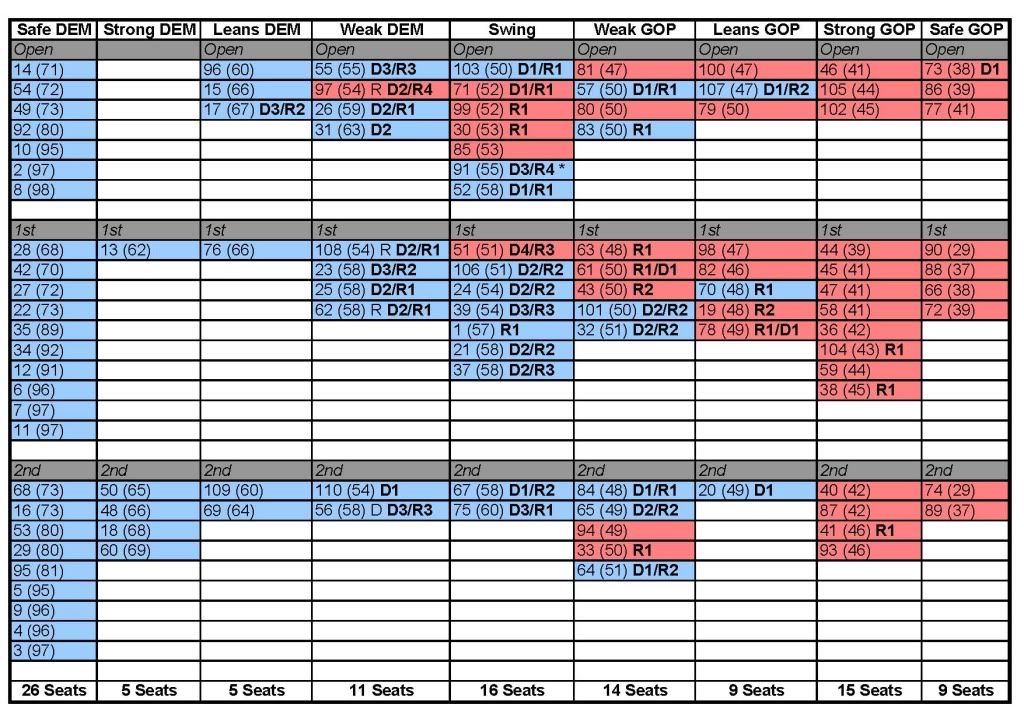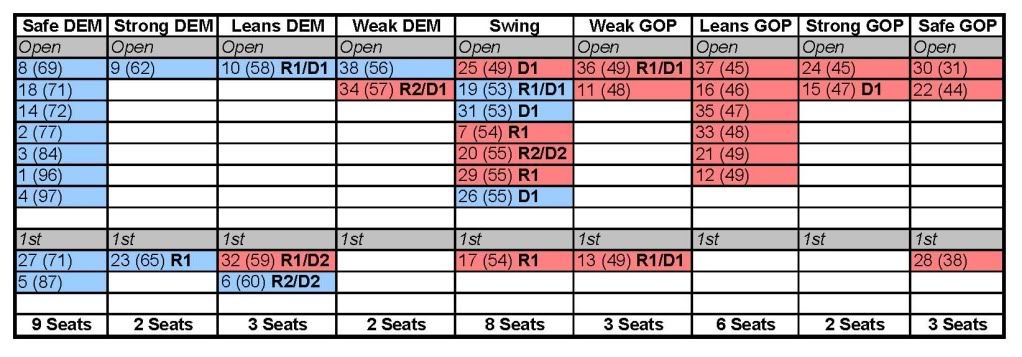(Cross-posted at ML and WMR and SSP-PB. If you have any questions, email me at pbratt@umich.edu)
In the 2008 cycle the Michigan Democratic Party emerged victorious for the second straight election, picking up nine seats to bring their seat total to 67 and helping President Barack Obama win the state in a landslide. However the 2010 cycle appears to be challenging for the party; defend its hold on the executive branch and the lower legislative chamber, while picking up the upper chamber, a victory that has eluded the party since 1984.
To better determine which seats in both the House and Senate will likely be targeted by each party, I’ve replicated research I did in the last election cycle on the funding that the MDP and the MRP gives to various candidates in the State House. I used Michigan Campaign Finance Network reports for 2002, 2004, 2006, and 2008 to see on what races each party put their money. Before analyzing the data I suspected that both parties would protect incumbents first, and then spend money on flipping open seats. I suspected that independent expenditures (from both parties) would also follow this logic. Finally, candidates that raised little money on their own would not receive any financial support from the state parties. I listed any race where there was an investment of over $15,000 from either party, and whether the seat was open or whether a party’s incumbent was defending the seat.
State House

http://i303.photobucket.com/al…
Figure 1: 2002 State House Races
Figure 1 shows the races that each party contested in 2002. The Republicans contested 18 seats, the Democrats 17. The Democrats contested 13 open seats and 3 Republican-held seats, while defending 1 seat. The GOP also contested 13 open seats and 1 Democratic-held seat, while defending 4 Republican seats. Of the 15 seats that each party actively contested, Democrats won 6, while the Republicans won 9.

http://i303.photobucket.com/al…
Figure 2: 2004 State House Races
As shown in Figure 2, the 2004 election cycle saw an increase in contested seats. The Republicans spent serious money on 21 seats, while the Democrats challenged in only 11 races. This difference may be a result of the large GOP money advantage for the state level races in this cycle. Regardless, the Democrats contested 7 open seats and 2 seats held by the GOP, while defending 2 Democratic seats. The GOP challenged 13 open seats and 4 Democratic seats, while defending 4 Republican seats. However, in the 10 races contested by each party, the Democrats won 7 seats. Of the 10 seats that the Democrats did not contest, the GOP won 7.

http://i303.photobucket.com/al…
Figure 3: 2006 State House Races
Figure 3 shows the total number of contested races decline in 2006. However, the Democrats increased the number of challenges, spending heavily in 17 races, while the GOP contested only 13 seats. Of the 17 races that the Democrats spent money on, 5 were open seats and 7 were held by the GOP, while 5 seats were defended. The GOP challenged 4 open seats and 2 Democratic seats, while defending 7 GOP seats. Of the 12 seats that both parties challenged, the Democrats won 8.

http://i303.photobucket.com/al…
Figure 4: 2008 State House Races
Figure 4 shows the total number of contested races in 2008. 31 races were seriously contested altogether; however, of these seats the Republicans contested 20, while the Democrats spent on 21. Of the 20 seats the GOP spent on, 14 were open seats, 3 were held by Republican incumbents, and 3 defended by Democratic incumbents. The Democrats challenged 14 open seats, defended 6 incumbents and challenged 1 Republican incumbent. Of the 10 seats that both parties challenged, the Democrats won 7. Interestingly, the Democrats spent large amounts of funds defining two relatively safe incumbents, Speaker of the House Andy Dillon (34% of his total funding was from the MDP) in District 17 and Mike Simpson in District 65 (55% of his total funding was from the MDP).
Over the past 4 election cycles, only 6 incumbents have fall to challengers. Two Democrats have lost (1 in 2002 and 1 in 2004), while 4 Republicans fell (1 in 2004 and 3 in 2006). Of the 47 races contested by each party between 2002 and 2008, the overwhelming majority have been open seats. All these seats are also Weak Democratic or Republican or Swing Seats.

http://i303.photobucket.com/al…
Figure 5: State House Competitiveness Matrix
Figure 5 is a chart displaying the expected competitiveness for Michigan State House races further. Each District has a Democratic baseline number in parenthesis, along with the number of times each party has challenged the seat. The Democratic baseline is determined by the Democratic share of the Board of Education vote for the election cycles between 2000 and 2008. For example, in House District 51 (in which the Democratic baseline is 51%), the Democrats have invested party resources in the seat four times, while the GOP has invested in it three times. It quickly becomes apparent that both parties rarely spend money defending or challenging seats in the Safe or Strong category or that of the opposing party. Hence, that gives the Democrats 31 worry free seats, and the Republicans 25. For an upset occur in these races means that the challenger needs to be self-financing, as the party will pay for nothing.
Hence both parties put their attention on the remaining 54 leaning, weak, and swing seats. Thus, expect the 11 Democratic and 9 Republican seats outside the Safe or Strong categories of either party that are open to be hotly contested. The Republicans will particularly contest three Republican-leaning seats held by Democratic Representatives in Districts 57, 83, and 107, although the GOP has done poorly in the Upper Peninsula over the past three cycles (This might change with Tom Casperson running for Mike Prusi’s 38th State Senate seat). On the opposing side the Democrats will look to pick up Districts 97, while challenging a number of swing seats (Districts 30, 71, and 85) that the Republicans currently hold. The GOP in turn will certainly try hard to pick up open Democratic swing seats (Districts 52, 91, and 103). Also expect the Republicans to try and knock off first-term Democratic incumbents in Districts 32, 70, and 101, although each of these candidates significantly outperformed the Democratic baseline in the last election cycle with vigorous campaigns.
If the Republican Party is serious about returning to a majority in the lower chamber, the party needs to in seats in Wayne County. Currently it holds only one based in Livonia, and this seat will likely face a Democratic challenger should the district get significantly redrawn in 2011 by the Democrats. While there was a significant Democratic wave in 2008, there is no indication that the Michigan voting population is moving to make the GOP the majority party in the lower chamber any time soon. Indeed, some long-term Republican Party strongholds are increasingly turning Democratic. Berrien County in southwestern Michigan, a long-term Republican stronghold, has seen its two State House districts become increasingly Democratic over the past three election cycles, and could be vulnerable to a strong Democratic candidate, especially in the open 79th District. While the GOP continues to do well in the exurban districts in the state, much of the party’s post 2004 decline has come from candidates losing in first-ring suburbs in metropolitan Detroit and in other metropolitan centers throughout the state.
Despite the potential opportunities, it is unlikely that the GOP will pick up the 13 seats it needs to regain a House majority in 2010. To do so the GOP would need to pick up all the open and first-term seats held by Democrats in Swing, Weak Republican, and Leaning Republican seats without the Democrats a single Democratic pickup, an unlikely event.
State Senate

http://i303.photobucket.com/al…
Figure 6: 2002 State Senate Races
Figure 6 shows the total number of contested races State Senate races in 2002. This was the first cycle in which a number of state senators were term-limited, and thus a number of competitive districts drawn up under the 2001 redistricting plan were open seats. Of the 38 seats in the senate, 13 were seriously contested altogether; with the Republicans contested 9, while the Democrats challenged 10. Of the 6 seats that both parties challenged, the Democrats won 2. The Democratic efforts in 2002 met with resounding failure, as the party won only 4 of the 10 seats contested, while the GOP won 7 of the 9 seats they spent substantial sums upon.

http://i303.photobucket.com/al…
Figure 7: 2006 State Senate Races
Figure 7 shows the total number of contested races State Senate races in 2006. With few open seats available to contest, both campaigns spend funds challenging specific races. As opposed to the 13 seats challenged in 2002, only 6 districts caught the attention of the parties in 2006, and the Democrats only challenged 4 districts. Of the 4 districts the Senate Dems challenged, the party picked up only 1 seat, while the GOP successfully held 5 of the 6 seats (including open seats) they were defending. Despite concentrating their financial support on only four districts, the Democrats were outspent by the Republicans in every district, and by substantial margins in the 13th and 34th Districts.

http://i303.photobucket.com/al…
Figure 8: State Senate Competitiveness Matrix
Figure 8 displays the competitiveness of the 38 State Senate seats. There are 11 seats that are Safe or Strong Democratic, while there are 5 Safe or Strong Republican districts. In all likeliness, the 6 Leaning GOP seats are going to be uncontested by the Democrats, simply because there are too many other seats to spent limited financial resources upon.
Districts 32 and 34 are likely to be among the most temping seats for the Democrats to contest. While District 34 is an open seat that has a strong Democratic candidate (State Representative Mary Valentine), District 32 is held by incumbent Republican senator Roger Kahn, who narrowly won against Democrat Carl Williams in 2006. What the Democrats need in the 32nd District is a strong candidate who can make strong contest against Kahn, who is likely to get piles of money from the GOP to hold this seat.
The GOP is in an unenviable situation in 2010. If Republican Mike Nofs picks up the open 19th District seat vacated by Democratic Congressman Mark Schauer, the GOP will have a 22-16 margin in the State Senate. Thus, the Democrats would need to pick up four seats to win the chamber. The Senate Republicans need to hold three seats in western Michigan where the Democrats have made strong electoral gains over the past two election cycles (District 20-Kalamazoo County, District 29-Grand Rapids and surrounding suburbs, and District 34-Muksegon County and three rural counties). If the Democrats pick up two of these three seats, the GOP needs to only lose one more seat to have a tied chamber. Unfortunately for the Republicans, Districts 7 (western Wayne County), District 13 (portions of Oakland County), and District 25 (Lapeer and St. Clair Counties) are all tossup seats.
A few Democratic seats could be potential Republican pickups. Mike Prusi’s 38th Senate District is open, and former Republican State Representative Tom Casperson is running for this district, which has a weak Democratic lean. If any Republican candidate can win this seat it is Casperson, who has a history of winning tough races, despite being pounded by Democratic Congressman Bart Stupak last year. Likewise, District 26 (Genesee County) and 31 (Bay County) are districts represented by popular senators (Jim Barcia and Deborah Cherry, respectively) who romped to victory in seats that are not as strongly Democratic as seem.